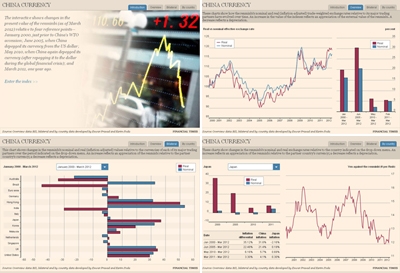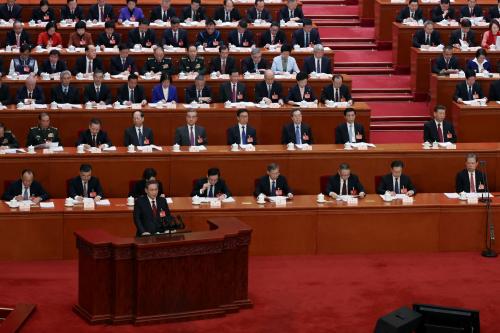The political pressure for China to allow for more currency appreciation remains strong even as the economic pressure on China’s currency to appreciate in value has temporarily dissipated. Liberalizing China’s currency regime is now less about correcting external imbalances than it is about helping to deal with domestic imbalances and promoting the currency’s international use.
 |
As the U.S.-China Strategic and Economic Dialogue begins this week, it is important to remember that the renminbi has in fact appreciated considerably against the dollar in recent years, especially when adjusted for inflation in China versus the U.S., as recently highlighted by U.S. Treasury Secretary Timothy Geithner at Brookings. It has also appreciated against the currencies of most of its major trading partners.
The interactive feature China Currency Tracker at FT.com shows changes in the present value of the renminbi (as of March 2012) relative to four reference points: January 2000, just prior to China’s WTO accession; June 2005, when China depegged its currency from the U.S. dollar; May 2010, when China again depegged its currency (after repegging it to the dollar during the global financial crisis); and March 2011, one year ago.
These changes are tracked not just for the U.S., but also China’s most important trading partners. Country by country, the China Currency Tracker illustrates the performance of the reniminbi in real and nominal terms.
Since 2000, the renminbi has appreciated in real terms significantly versus Japan, the U.K. and the U.S., appreciated modestly relative to Germany, and stayed almost unchanged relative to the euro. The renminbi has depreciated significantly relative to the Australian dollar, Indian rupee and Brazilian real, primarily due to higher inflation in those countries compared to China.
Over the past year, the renminbi has appreciated in both nominal and real terms relative to all of its trading partners.
On the policy front, China’s central bank recently announced a significant step in the road toward greater exchange rate flexibility— a widening of the trading band for the renminbi relative to the U.S. dollar. A more flexible currency is an important step on the path to an open capital account, and liberalizing its currency regime is a prerequisite if China is serious about making the renminbi a powerhouse global currency.
Increasing exchange rate flexibility will help promote the balance and sustainability of China’s economic development as well as the renminbi’s role in the global monetary system. Focusing on flexibility of the currency rather than a “desirable” level of the renminbi is a more productive approach for the U.S. and the international community to engage with China on the currency issue. And one that Chinese policymakers ought to take to heart as being in their own interest.


Commentary
Tracking China’s Currency Ahead of the U.S.-China Strategic & Economic Dialogue
May 1, 2012